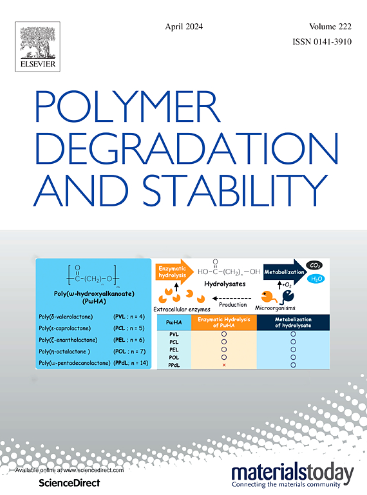Chemical aging and degradation of stereolithographic 3D-printed material: Effect of printing and post-curing parameters
IF 6.3
2区 化学
Q1 POLYMER SCIENCE
引用次数: 0
Abstract
Stereolithography (SLA) 3D printing materials have gained significant interest due to their potential applications in various industries, including material processing, microfluidic devices, medical devices, and lightweight engineering. However, their mechanical and chemical properties can be influenced by printing, post-processing, and aging. This research investigated the mechanical performance of a methacrylate-based material produced under different printing and post-curing conditions and explored its chemical degradation. The test specimens were additively manufactured with different print orientations (POs) and layer heights (LHs), followed by post-curing at various temperatures and durations, and then artificially aged in 6 M HNO3. Tensile tests, nano-indentation, FTIR, and microscopic analyses were conducted before and after aging. The outcomes revealed that PO had limited influence on mechanical performance, except for the 0˚ PO, which showed inferior performances compared to 45˚ and 90˚ samples. Conversely, post-curing parameters, particularly curing temperature, significantly impacted final properties. FTIR analysis confirmed that post-curing increases the degree of conversion (DOC), thus resulting in enhanced ultimate stress and modulus. However, a higher DOC was associated with more brittleness. Regarding chemical degradation, the PO and curing temperature were the most influential factors, with the 0˚ PO showing reduced swelling and degradation; and higher curing temperatures resulting in lower degradation. On the other hand, LH showed mixed effects on mechanical performance and degradation. These findings address critical gaps in current research on 3D-printed polymer performance and degradation, offering insights into the application of additively manufactured polymer materials in various industrial settings.
立体光刻(SLA)三维打印材料因其在材料加工、微流体设备、医疗设备和轻质工程等各行各业的潜在应用而备受关注。然而,它们的机械和化学特性会受到打印、后处理和老化的影响。本研究调查了在不同印刷和后固化条件下生产的甲基丙烯酸酯基材料的机械性能,并探讨了其化学降解问题。测试试样采用不同印刷方向(POs)和层高(LHs)的添加式制造,然后在不同温度和持续时间下进行后固化,再在 6 M HNO3 中进行人工老化。老化前后进行了拉伸试验、纳米压痕、傅立叶变换红外光谱和显微分析。结果表明,PO 对机械性能的影响有限,只有 0˚ PO 的性能低于 45˚ 和 90˚ 样品。相反,后固化参数,尤其是固化温度,对最终性能有很大影响。傅立叶变换红外分析证实,后固化会增加转化度(DOC),从而提高极限应力和模量。但 DOC 越高,脆性越大。在化学降解方面,PO 和固化温度是最重要的影响因素,0˚ PO 会减少膨胀和降解;固化温度越高,降解越低。另一方面,LH 对机械性能和降解的影响不一。这些发现填补了目前有关三维打印聚合物性能和降解研究的重要空白,为添加制造聚合物材料在各种工业环境中的应用提供了启示。
本文章由计算机程序翻译,如有差异,请以英文原文为准。
求助全文
约1分钟内获得全文
求助全文
来源期刊

Polymer Degradation and Stability
化学-高分子科学
CiteScore
10.10
自引率
10.20%
发文量
325
审稿时长
23 days
期刊介绍:
Polymer Degradation and Stability deals with the degradation reactions and their control which are a major preoccupation of practitioners of the many and diverse aspects of modern polymer technology.
Deteriorative reactions occur during processing, when polymers are subjected to heat, oxygen and mechanical stress, and during the useful life of the materials when oxygen and sunlight are the most important degradative agencies. In more specialised applications, degradation may be induced by high energy radiation, ozone, atmospheric pollutants, mechanical stress, biological action, hydrolysis and many other influences. The mechanisms of these reactions and stabilisation processes must be understood if the technology and application of polymers are to continue to advance. The reporting of investigations of this kind is therefore a major function of this journal.
However there are also new developments in polymer technology in which degradation processes find positive applications. For example, photodegradable plastics are now available, the recycling of polymeric products will become increasingly important, degradation and combustion studies are involved in the definition of the fire hazards which are associated with polymeric materials and the microelectronics industry is vitally dependent upon polymer degradation in the manufacture of its circuitry. Polymer properties may also be improved by processes like curing and grafting, the chemistry of which can be closely related to that which causes physical deterioration in other circumstances.
 求助内容:
求助内容: 应助结果提醒方式:
应助结果提醒方式:


